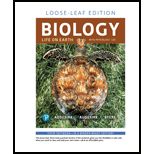
Concept explainers
Introduction:
An organism’s genotype is the number of different alleles for a particular trait present in it, whereas
Answer to Problem 1MC
Correct answer:
The physical position of a gene on a chromosome is its locus; slightly different forms of a gene are called alleles. Therefore, option (a) is correct.
Option (a) is given as “locus; alleles”.
Explanation of Solution
Justify reason for the correct statement:
An allele is any of the alternative forms of a gene that may occur at a specific locus and the combination of alleles for a genotype of an organism for expression of a particular phenotype.
Hence, option (a) is correct.
Justify reasons for the incorrect statements:
Option (b) is given as “locus; polygenic”.
The particular location of any gene in the genome is termed as locus and polygenic is an inheritance pattern of a trait that is controlled by the two or more genes. Hence, it is a wrong answer.
Option (c) is given as “chiasma; alleles”.
Alleles are responsible for any particular trait in any organism and chiasma is the site where chromosomes come in contact with each other during crossing over. Hence, it is a wrong answer.
Option (d) is given as “trait and hybrids”.
Traits are the characters carried by any individual, and hybrids contain two alleles for the same trait. Hence, it is a wrong answer.
Hence, options (b), (c), and (d) are incorrect.
Locus provides a physical position to a gene on the chromosome, whereas alleles are the different form of a particular gene.
Want to see more full solutions like this?
Chapter 11 Solutions
Pearson eText Biology: Life on Earth with Physiology -- Instant Access (Pearson+)
- Gregor mendels experiments sought to discover if he could find the rules that govern A. Genetics B. Heredity C. Meiosis D. Mutationsarrow_forwardSimilarities in________ are the basis of similarities in traits. a. karyotype c. the double helix b. DNA sequence d. chromosome numbearrow_forwardA recognized set of symptoms that characterize a genetic disorder is a(n)______ . a. syndrome c. abnormality b. disease d. inheritance patternarrow_forward
- An individual with two different alleles at a locus is a(n) Group of answer choices A. clone B. hemizygote C. homozygote D.heterozygotearrow_forwardThis example can be considered as ______________. A.Modifier gene B.Gene redundancy C.Co-dominance D.Incomplete dominancearrow_forwardMaple syrup urine disease is an autosomal recessive gene. The R allele leads to a normal protein product, whereas r leads to a mutant protein. Which genotype below will display the Maple syrup urine disease phenotype? A. Rr B. RR C. rr D. Rr and rrarrow_forward
- In agriculture, polyploid crops (like coffee, strawberries, or bananas) tend to produce ________. a. more uniformity b. more variety c. larger yields d. smaller yieldsarrow_forwardWhich of the following is a phenotype? a. Aa b. red hair c. Heterozygous d. DNAarrow_forwardRed-green color blindness is a recessive trait in humans. The locus is on the X chromosome. If a color blind woman marries a normal vision man, what kind of children could they have? Group of answer choices A. color blind daughters, normal vision sons B. color blind sons, normal vision daughters C. all color blind D. all normal visionarrow_forward
- Phenotype is the allele combinations of an individual that cause traits or diseases. Genotype is the expression of a gene in traits or symptoms. A. Both statements are correct B. Both statements are incorrect C. First statement is Correct, Second is Incorrect D. First statement is Incorrect, Second is Correctarrow_forwardMost of the genetic information we will get from our genome will not be hard evidence that we will or we won’t get a disease but is rather only probabilistic evidence. a. What does this mean? b. Why might knowing a single gene not tell you if you will get a particular condition?arrow_forwardA test cross is performed to determine if a specific individual is a carrier. The results generate a 50/50 ratio of phenotypes. The test subject is therefore ________. A. Unable to reproduce B. Homozygous recessive C. Not following the rules of Mendelian genetics D. Homozygous dominant E. Heterozygousarrow_forward
